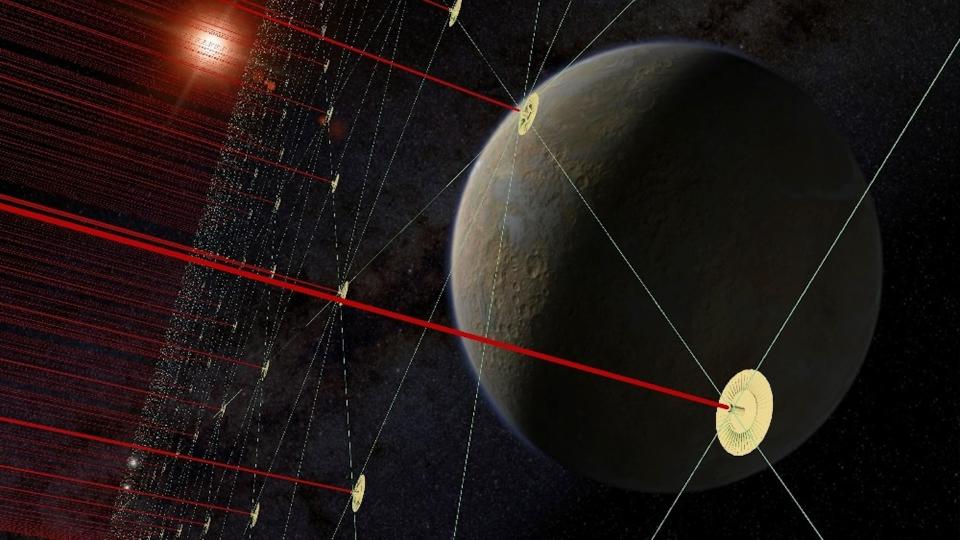When you buy through links on our articles, Future and its syndication partners may earn a commission.

Our space-exploration ambitions have boldly taken humans to the moon, rovers to Mars and spacecraft to the outer reaches of the solar system. But could humans or spacecraft ever reach Alpha Centauri, the closest star system to our planet?
Alpha Centauri is about 4.4 light-years (roughly 25 trillion miles, or 40 trillion kilometers) from Earth and is home to three separate stars. The closest star, Proxima Centauri, also hosts an exoplanet that scientists believe could have the conditions necessary for life.
But reaching this star system would be no small feat. NASA estimates that, using a space shuttle like NASA’s now-retired 122-foot-long (38 meters) Discovery, it would take close to 150,000 years to reach Alpha Centauri.
If humans could travel at the speed of light, we could reach Alpha Centauri in four years flat. However, the laws of physics dictate that only massless light particles called photons can reach this cosmic speed limit. So, while humans will probably never reach Alpha Centauri, it’s possible that spacecraft designed to go a much smaller fraction of the speed of light could reach these stars in a human lifetime. To even hope of getting a spacecraft up to top speed, scientists will need something much smaller than Discovery.
Marshall Eubanks, CEO of the startup Space Initiatives Inc and a fellow at NASA Innovative Advanced Concepts, is researching remote methods for visiting Proxima Centauri using swarms of picometer-sized spacecraft. (A picometer is one-trillionth of a meter.)
Related: What could aliens look like?


“We are in the midst of a real revolution in space flight and space exploration, with extremely small systems,” Eubanks told Live Science in an email. “While an individual small spacecraft will not be as capable as a larger spacecraft, such as the Voyagers, their development times are much shorter; they are relatively inexpensive.”
Tiny spacecraft also require less power to propel them, which could be a key advantage in increasing their speed.
Eubanks isn’t the only one pursuing this kind of research. Breakthrough Initiatives started its Starshot project in 2016 to combine nanometer-sized spacecraft with light sails, and in 2017, NASA began funding its own project targeted at launching a mission to Alpha Centauri by 2069, 100 years after Apollo 11.
While small spacecraft are easier to accelerate than larger probes, traditional fuel sources alone are not powerful or plentiful enough to push these craft to near light speed. Instead, Philip Lubin, a professor of physics at the University of California, Santa Barbara whose ideas for interstellar travel inspired the Starshot team, told Live Science that these craft will likely rely on light instead.


Solar energy
To go fast in space, it helps to be small and have low mass. One major benefit of light-powered propulsion is that it’s mass-less, Lubin said. Traditional rocket fuel, in contrast, creates propulsion by transforming heavy fuel into energy by burning it. Using either a solar sail, which is propelled by the sun’s light, or a photonic sail, which is propelled by laser light, gives you all of the power without any of the weight.
Lubin said you can think of it like throwing a ball at a piece of paper. When a ball strikes the paper, it will apply a force, causing the paper to recoil or be pushed away. Similarly, the momentum carried by light is transferred to the spacecraft, which causes it to recoil and accelerate.
“The system is basically a gigantic flashlight — it’s a giant laser array [on Earth],” Lubin said. If the spacecraft are sailboats, then the laser light is the wind in their sails.
Technology to create and test these craft, such as communications equipment small enough to fit on them, is still being developed. But there’s no physical reason to believe that such a spacecraft couldn’t conduct a flyby mission of Alpha Centauri, Lubin said.
RELATED MYSTERIES
—How many space rocks hit the moon every year?
—How many stars in the Milky Way die each year?
—Have all 8 planets ever aligned?
This mission could behave much like the Voyager 1 and 2 probes and transmit high-resolution images of the star system back to Earth, some of which might contain our first look at Proxima Centauri’s potentially habitable planet.
While Lubin stressed that a journey to Alpha Centauri would be a long-term endeavor, Eubanks said he’s confident that big advances could come this century.
“I think that we will reach the Alpha Centauri system, with small probes launching in the decade of the 2040s, and thus arriving in the 2060s,” Eubanks said. “Significantly larger probes should be possible by the end of the century, but without unexpected breakthroughs in propulsion physics, I think that crewed missions will be a task for the next century.”
Source Agencies



